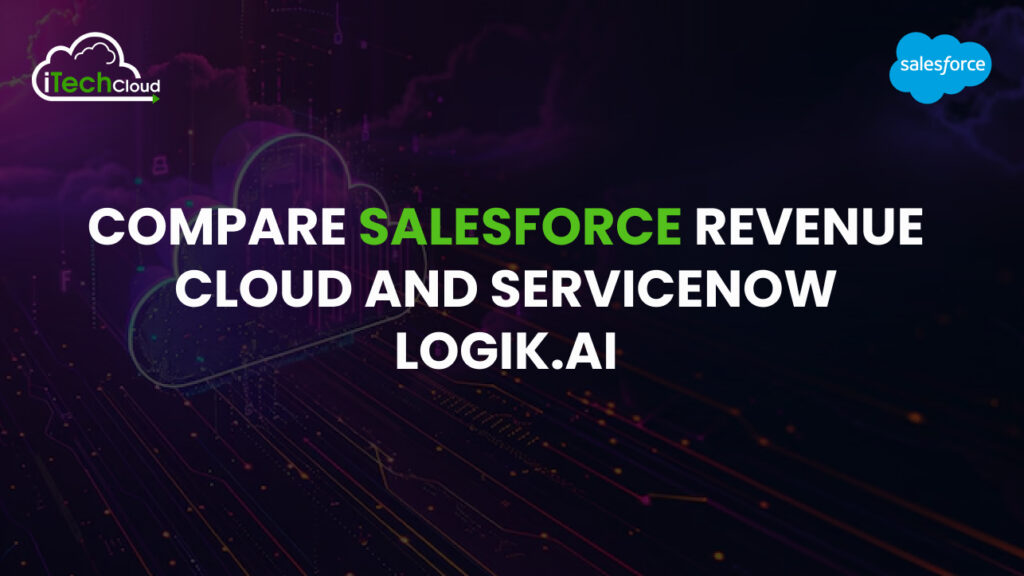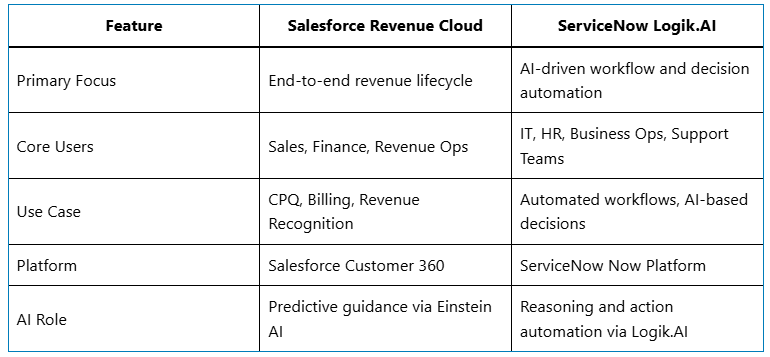Compare Salesforce Revenue Cloud and ServiceNow Logik.AI

In a digital world where customer expectations are rising and revenue models are becoming more complex, companies must embrace platforms that unify processes, enhance intelligence, and drive automation. Two such powerful enterprise tools are Salesforce Revenue Cloud and ServiceNow Logik.AI have emerged as leaders in their respective domains. While they serve different core purposes, both aim to simplify and transform the way businesses operate.
In this blog, we’ll explore and compare these two solutions in-depth from their fundamental architectures to their AI capabilities, use cases, and more so you can better understand which solution aligns with your business goals.
Table of Contents
What is Salesforce Revenue Cloud?
Salesforce Revenue Cloud is an integrated platform designed to help organizations manage every aspect of the revenue lifecycle. Built on the powerful Salesforce Customer 360 platform, Revenue Cloud brings together Configure-Price-Quote (CPQ), billing, Partner Relationship Management (PRM), and subscription management in a single, unified ecosystem.
It’s primarily built for sales, finance, and operations teams to ensure a seamless, error-free quote-to-cash journey while providing real-time visibility into revenue and sales performance.
Core Capabilities:
- CPQ (Configure-Price-Quote): Enables accurate product configuration and dynamic pricing.
- Billing: Automates invoice creation, payment tracking, and usage-based billing.
- Revenue Recognition: Helps comply with accounting standards like ASC 606 and IFRS 15.
- Subscription Management: Manages renewals, upgrades, and recurring payments.
- Partner Enablement: Provides tools for indirect sales channels and distributors.
What is ServiceNow Logik.AI?
ServiceNow Logik.AI is an intelligent automation engine that enables businesses to automate decision-making across workflows using generative AI and logical reasoning. Acquired by ServiceNow in 2023, Logik.AI extends the power of the Now Platform by making decisions using a combination of natural language processing, context understanding, and logic programming.
Its goal is not to manage revenue directly like Revenue Cloud but to enhance productivity and automation across IT, HR, legal, and service operations through smarter, AI-driven decisions.
Core Capabilities:
- Natural Language Understanding (NLU): Users can ask questions or issue commands in plain English.
- Decision Automation: Uses rule-based logic and AI to simulate human reasoning.
- Workflow Integration: Seamlessly integrates with ServiceNow’s existing workflows.
- Data Interpretation: Understands structured and unstructured data to automate decisions.
Core Differences: Purpose and Focus

AI and Automation: Smarts Behind the Scenes
Salesforce Revenue Cloud and Einstein AI
Salesforce integrates Einstein AI to bring smart automation to the sales and revenue lifecycle. It offers:
- Predictive Forecasting: Analyze past trends and suggest future revenue.
- Smart Product Bundling: Recommends best-fit product bundles to sales reps.
- Quote Guidance: Uses AI to suggest optimal discounting strategies.
- Renewal Alerts: Automatically alerts sales to upsell or cross-sell opportunities.
Einstein operates as a recommendation engine that helps improve accuracy, speed, and customer satisfaction in the quote-to-cash pipeline.
ServiceNow Logik.AI’s Intelligent Reasoning
Logik.AI functions more like a thinking assistant than a recommendation engine. It interprets complex queries like
“If an incident is created by a VIP user and has a critical priority, then notify a senior engineer and bypass tier-1 support.”
With Logik.AI:
- You don’t need to hard-code this logic.
- The system understands the request, finds the relevant data, and configures the workflow.
It supports natural language commands, adapts to changing business rules, and continuously improves by learning from decisions and interactions.
Use Case Comparison
Salesforce Revenue Cloud – Practical Scenarios
1. Enterprise CPQ: A telecom provider with thousands of customizable product bundles uses Revenue Cloud to automate quote generation.
2. Usage-Based Billing: A SaaS company tracks customer usage and generates invoices automatically using integrated billing.
3. Partner Sales: A manufacturer enables distributors to generate accurate quotes through a branded partner portal.
4. Revenue Forecasting: A CFO aligns pipeline data from Sales Cloud with billing information to predict future cash flows.
ServiceNow Logik.AI – Practical Scenarios
1. IT Incident Management: Logik.AI analyzes incident patterns and suggests automated triaging rules to reduce ticket backlog.
2. HR Request Automation: Automatically determines eligibility for parental leave based on employee profile and local regulations.
3. Vendor Onboarding: AI dynamically routes approval workflows based on vendor risk profile.
4. Security Alert Escalation: Analyzes alerts from multiple tools and applies business rules to prioritize response.
Strengths and Advantages
Why Choose Salesforce Revenue Cloud?
- All-in-One Quote-to-Cash: Reduces siloed systems and manual handoffs.
- Deep CRM Integration: Works natively with Sales Cloud, Service Cloud, and Marketing Cloud.
- Scalable for Any Business Size: From SMBs to enterprises.
- Trusted by Finance Teams: Meets compliance and audit standards.
- Omnichannel Sales Support: Sell via direct sales, partners, and digital channels.
Why Choose ServiceNow Logik.AI?
- AI-First Automation: No need to define every rule manually.
- Better Business Agility: Quickly adapt to changes in policies or workflows.
- Works Across Departments: From IT to HR to Legal.
- User-Friendly: Even non-technical users can automate decisions using natural language.
- Powered by the Now Platform: Leverages existing investments in ServiceNow.
Limitations to Consider
Salesforce Revenue Cloud Limitations:
- Steep Learning Curve: Especially for CPQ and billing setup.
- Implementation Time: Full deployments can take several months.
- High Licensing Cost: Enterprise-grade features can be expensive for small businesses.
ServiceNow Logik.AI Limitations:
- Still Emerging: As a newer offering, it may lack features for niche industries.
- Primarily for Workflow Automation: Not suitable for revenue-focused needs.
- Dependence on Now Platform: Best used in conjunction with other ServiceNow modules.
Pricing and Licensing
Salesforce Revenue Cloud pricing is typically user-based, with additional costs for:
- CPQ add-ons
- Billing and subscription modules
- Partner portal access
Large enterprises may also require custom development and integration, which increases the total cost of ownership.
ServiceNow Logik.AI pricing is usually part of an enterprise subscription, calculated based on:
- Number of workflows
- AI usage volume
- Existing ServiceNow modules
Since it’s relatively new, pricing models are still evolving and often negotiated on a case-by-case basis.
Integration and Ecosystem
Salesforce Revenue Cloud:
- Native integration with Sales, Service, and Experience Cloud.
- AppExchange offers hundreds of extensions for CPQ, billing, and finance.
- MuleSoft can be used for external integrations with ERPs like SAP and Oracle.
ServiceNow Logik.AI:
- Deep integration with ITSM, HRSD, and Security Operations modules.
- Built on Now Platform for seamless workflow orchestration.
- Works with external AI models like OpenAI or Anthropic via IntegrationHub.
Conclusion
While Salesforce Revenue Cloud and ServiceNow Logik.AI tackle different parts of the business puzzle, they both aim to simplify complexity and improve decision-making.
Salesforce Revenue Cloud is ideal for businesses looking to transform their quote-to-cash process, manage revenue streams, and improve financial transparency. On the other hand, ServiceNow Logik.AI is a forward-looking solution built to automate logic-heavy workflows using cutting-edge AI reasoning.
In many large organizations, these tools can coexist Revenue Cloud streamlining the financial side and Logik.AI accelerating operational efficiency. The synergy between structured revenue processes and intelligent, flexible decision automation could represent the future of enterprise optimization.

